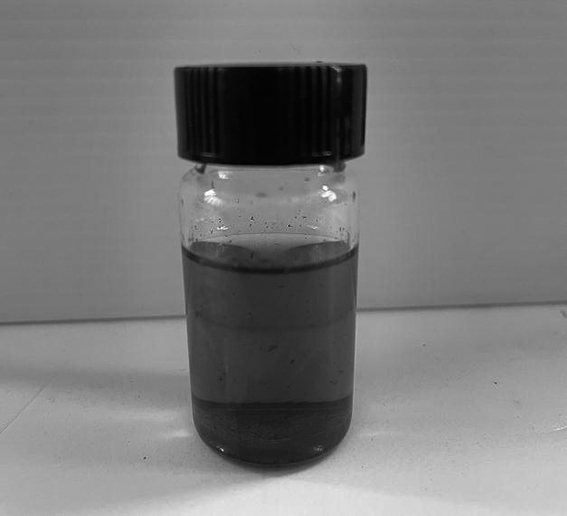Preparation method of electrolyte of iron-chromium flow battery and obtained electrolyte
A liquid flow battery and electrolyte technology, applied in the field of energy storage, can solve the problems of reducing battery performance, ion crossing and interlinking, etc., to achieve the effect of increasing the precipitation potential, reducing the amount of hydrogen evolution, and slowing down the performance decay
- Summary
- Abstract
- Description
- Claims
- Application Information
AI Technical Summary
Problems solved by technology
Method used
Image
Examples
Embodiment 1
[0050] (1) Prepare a 4 mol / L hydrochloric acid solution, add a certain amount of propylenediaminetetraacetic acid and chromium ion complex CrPDTA into the prepared hydrochloric acid solution, and stir with a magnetic bar for 2 hours at a temperature of 60 °C to form a uniform solution. solution. The preparation process of the complex is as follows: 40g KCr(SO4) 2 ·12H 2 O and 27.5 g PDTA were dissolved in deionized water at 100 °C. After heating for 1 h, 10 g KOH was added slowly. After 24 h, 16 mL of 5 mol / L KOH was slowly added in 1 mL increments. The process continued for 72 h, so that the final The pH of the solution is between 5 and 6, the solution is cooled to room temperature, 90 mL of acetone is added, and K is precipitated to remove 2 SO 4 , diluted with deionized water to obtain a 1 mol / L K[CrPDTA] solution.
[0051] (2) Prepare a 4 mol / L hydrochloric acid solution, add a certain amount of ferric chloride and ferrous chloride to the prepared hydrochloric acid sol...
Embodiment 2
[0054] (1) Prepare a 4 mol / L hydrochloric acid solution, add a certain amount of red carbon quantum dots and chromium chloride into the prepared hydrochloric acid solution, at 60 o At the temperature of C, the solution was stirred with a magnet for 2 h to form a homogeneous solution, in which the concentration of red carbon quantum dots was 0.2 mol / L and the concentration of chromium chloride was 0.25 mol / L. Among them, the preparation process of the red carbon quantum dot additive is as follows. Weigh 0.01 g of torus acid and 0.35 g of o-phenylenediamine, add them into a hydrothermal reaction kettle, add 10 ml of aqueous sulfuric acid (3.4 mol / L) to dissolve, and dissolve at 210 o Heated at C for 10h. The prepared solution was filtered through a membrane filter (0.22 μm), then precipitated with NaOH aqueous solution, and 3 ml of quantum dot solution was added with 5 ml of 2.5 mol / L NaOH aqueous solution. Finally, the pellet was collected by centrifugation at 10,000 rpm / min f...
Embodiment 3
[0058] (1) Prepare a 4 mol / L hydrochloric acid solution, add a certain amount of zinc-doped blue carbon quantum dots and chromium chloride into the prepared hydrochloric acid solution, at 60 o At the temperature of C, the solution was stirred with a magnet for 2 h to form a homogeneous solution, in which the concentration of zinc-doped blue carbon quantum dots was 0.2 mol / L, and the concentration of chromium chloride was 0.25 mol / L. Among them, the preparation process of zinc-doped blue carbon quantum dot additive is as follows. Weigh 1.74 g of sodium citrate and 0.35 g of zinc chloride samples respectively and dissolve sodium citrate and zinc chloride in 50 mL of ultrapure water. The concentration ratio is 1:0.5. After fully dissolving the solution, add it to a hydrothermal kettle with a total volume of 100 mL. in 185 o C for 4 hours. After cooling to room temperature, filter through a 0.22 µm disposable syringe filter and then filter through a Spirax dialysis bag 100-500 ...
PUM
 Login to View More
Login to View More Abstract
Description
Claims
Application Information
 Login to View More
Login to View More - Generate Ideas
- Intellectual Property
- Life Sciences
- Materials
- Tech Scout
- Unparalleled Data Quality
- Higher Quality Content
- 60% Fewer Hallucinations
Browse by: Latest US Patents, China's latest patents, Technical Efficacy Thesaurus, Application Domain, Technology Topic, Popular Technical Reports.
© 2025 PatSnap. All rights reserved.Legal|Privacy policy|Modern Slavery Act Transparency Statement|Sitemap|About US| Contact US: help@patsnap.com



